#Vilnius Church Heritage Museum
Explore tagged Tumblr posts
Text








#royal treasures#historical treasures#medieval europe#Vilnius Cathedral#Alexander Jagiellon#Aleksandras Jogailaitis#king of poland#grand duke of lithuania#Elizabeth of Austria#burial insignia#coffin plaque#Barbara Radziwill#Sigismund II Augustus#monarch#lithuania#poland#vilnius#necropolis#Grand Duchy of Lithuania#Vilnius Church Heritage Museum#endoscopic camera#15th century#16th century#1400s#1500s#cathedral#world war 2#priceless#artifacts.#royal
14 notes
·
View notes
Text

Royal Treasures Hidden Since World War II Recovered From Cathedral
Historical treasures hidden for decades have been uncovered in the crypts of a cathedral, with items including burial crowns and insignia belonging to Medieval European rulers.
The cache from Vilnius Cathedral, in Lithuania, has not been seen since the outbreak of World War II in 1939, according to a press release from Go Vilnius tourism promotion agency on Wednesday.
Items include a crown belonging to Alexander Jagiellon, or Aleksandras Jogailaitis, King of Poland and Grand Duke of Lithuania, who lived from 1461–1506.
Other artifacts include a crown, a chain, a medallion, a ring and a coffin plaque belonging to Elizabeth of Austria, or Elžbieta Habsburgaitė, who lived from 1436–1505.


There was also a crown, a scepter, an orb, three rings, a chain and coffin plaques associated with Barbara Radziwiłł, or Barbora Radvilaitė. She was married to Sigismund II Augustus, or Žygimantas Augustas, King of Poland and Grand Duke of Lithuania, and died in 1551.
“The discovered burial insignia of the monarchs of Lithuania and Poland are priceless historical treasures, symbols of the long tradition of Lithuanian statehood, signs of Vilnius as the capital city, and magnificent works of goldsmithing and jewellery,” said Vilnius Archbishop Gintaras Grušas in a statement by the Vilnius Archdiocese on Thursday.
The artifacts would have been put inside the sarcophagi of the royals when they were laid to rest, and the crowns would not have been worn, instead being made after death to form part of the burial tomb, according to the statement.



“This reflects the burial and honouring practices of the time,” the statement adds. “This discovery is of particular importance for our statehood, as it shows the location of Vilnius Cathedral as the necropolis of the elite of the Grand Duchy of Lithuania.”
“These symbols are important both for the State and for each of us, as signs of European identity, as a reclaimed identity of the old State, as a sign of the strength of our roots,” said Rita Pauliukevičiūtė, director of the Vilnius Church Heritage Museum, in the Archdiocese statement.
The items were first discovered in 1931 when the cathedral was being cleaned following a spring flood, revealing a crypt containing the remains of the rulers.


They were put on display until World War II broke out in 1939, when they were hidden. Several fruitless searches were carried out before researchers turned their attention to the crypts in September 2024.
Using an endoscopic camera, the artifacts were finally recovered in December, wrapped in newspapers dated September 1939.
“They will be examined, restored and presented to the public in the future,” according to the archdiocese.
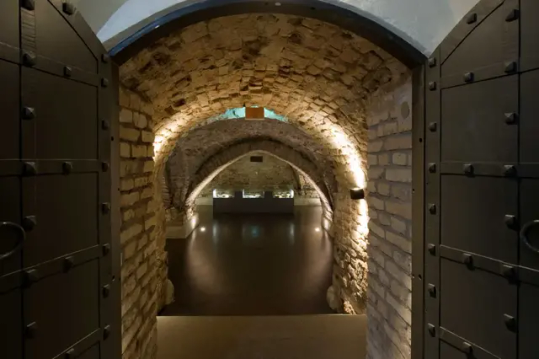
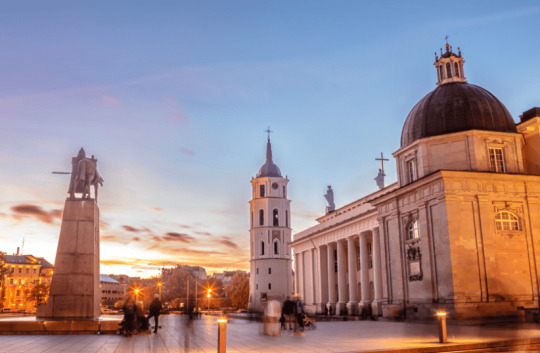
#Royal Treasures Hidden Since World War II Recovered From Cathedral#Vilnius Cathedral#Lithuania#crown#artifacts#archaeology#archeolgst#history#history news#ancient artifacts#ancient art
116 notes
·
View notes
Text
youtube
We had a quick visit to Vilnius, Lithuania, a UNESCO World Heritage Site.
The number of Baroque churches dazzles any visitor.
We visited Old Town, Vilnius Cathedral, the hill of Three Crosses, the KGB Museum, which is a must to learn the recent history and what is at stake for the people of Lithuania and the people of the Baltic states.
#art #religion #peace #vilnius #lithuania #baltics #putin #russia
1 note
·
View note
Text
Exploring the Enchanting Baltics: From Dhaka to Estonia, Latvia, and Lithuania

Embarking on a journey from Dhaka to the Baltic States of Estonia, Latvia, and Lithuania unveils a rich tapestry of history, culture, and natural splendor. These three nations, nestled along the Baltic Sea, offer an extraordinary blend of medieval charm, modern sophistication, and breathtaking landscapes.
Estonia: A Step Back in Time
Our adventure began in Estonia, a country renowned for its seamless integration of medieval heritage and contemporary innovation.
Tallinn’s Old Town: The medieval heart of Tallinn, with its cobbled streets and well-preserved Hanseatic architecture, made us feel like we had stepped into a fairy tale. Highlights included the majestic Alexander Nevsky Cathedral and the panoramic views from Toompea Hill.
Kumu Art Museum: The Kumu Art Museum provided a fascinating journey through Estonian art, from classical to contemporary works. The museum’s striking modern design was a sharp contrast to the historic surroundings of Tallinn’s Old Town.
Lahemaa National Park: A visit to Lahemaa National Park offered a serene escape into Estonia's natural beauty. We wandered through dense forests, explored rugged coastlines, and visited charming manors, soaking in the tranquility and pristine landscapes.
Latvia: Where Tradition Meets Innovation
Our next stop was Latvia, a country where historic richness and modern vibrancy coexist harmoniously.
Riga’s Old Town: Riga’s Old Town enchanted us with its colorful facades and stunning Art Nouveau architecture. The lively atmosphere of Dome Square and the views from St. Peter’s Church were particularly memorable.
Riga Central Market: Situated in repurposed Zeppelin hangars, Riga Central Market was a sensory delight. We savored local specialties such as smoked fish, fresh produce, and traditional pastries, experiencing the flavors of Latvia firsthand.
Jūrmala Beach: Just a short drive from Riga, Jūrmala offered a peaceful retreat with its sandy beaches and quaint wooden houses. Strolling along the coast and enjoying the sea breeze was a perfect way to unwind.
Lithuania: A Tapestry of History and Culture
Lithuania, our final destination, captivated us with its rich history, cultural heritage, and picturesque landscapes.
Vilnius Old Town: Vilnius, with its Baroque architecture and vibrant arts scene, was a cultural treasure. The Gediminas Castle Tower provided stunning views over the city, while the bustling Pilies Street was alive with cafes and street performers.
Trakai Island Castle: Located on an island in Lake Galvė, Trakai Island Castle was a highlight of our Lithuanian journey. The medieval fortress, surrounded by tranquil waters, offered a glimpse into Lithuania's storied past.
Hill of Crosses: Near the city of Šiauliai, the Hill of Crosses was a profoundly moving site. Thousands of crosses of varying sizes and styles created a powerful symbol of faith and resilience, making it a deeply spiritual experience.
Practical Tips for Bangladeshi Travelers
For Bangladeshi travelers, planning a trip to the Baltics is made easier with the assistance of travel agencies such as Roomchai, ShareTrip, and GoZayaan. These agencies provide comprehensive packages and support, including visa assistance, accommodation bookings, and tailored itineraries.
Visa and Documentation: Begin the Schengen visa application process well in advance, ensuring all necessary documents are meticulously prepared.
Accommodation: Secure accommodations early, opting for centrally located hotels in urban areas and charming guesthouses in rural settings.
Local Transport: Utilize efficient public transportation within cities and consider renting a car for exploring the scenic countryside.
Cuisine and Cultural Etiquette: Delight in the diverse culinary offerings of the Baltics and learn basic phrases in Estonian, Latvian, and Lithuanian to enhance your travel experience.
Conclusion
Journeying from Dhaka to Estonia, Latvia, and Lithuania opens up a world of medieval wonders, vibrant cities, and stunning natural landscapes. With the guidance of travel agencies, Bangladeshi travelers can seamlessly navigate the intricacies of travel planning and immerse themselves in the enchanting beauty of the Baltic States. This adventure promises unforgettable memories and a deeper appreciation of these captivating countries.
1 note
·
View note
Text
FOMA 38: Five Examples of Sacral Architecture in Kaunas
In June 1940, Soviet army entered Lithuania. This was a beginning of a 50 year long occupation. Catholic Church was one of the biggest enemies of the Soviet Union. Because of atheist policy, churches and other sacral buildings of all confessions were being closed and turned into warehouses, sport halls and galleries, therefore ignoring their architectural and cultural heritage value.
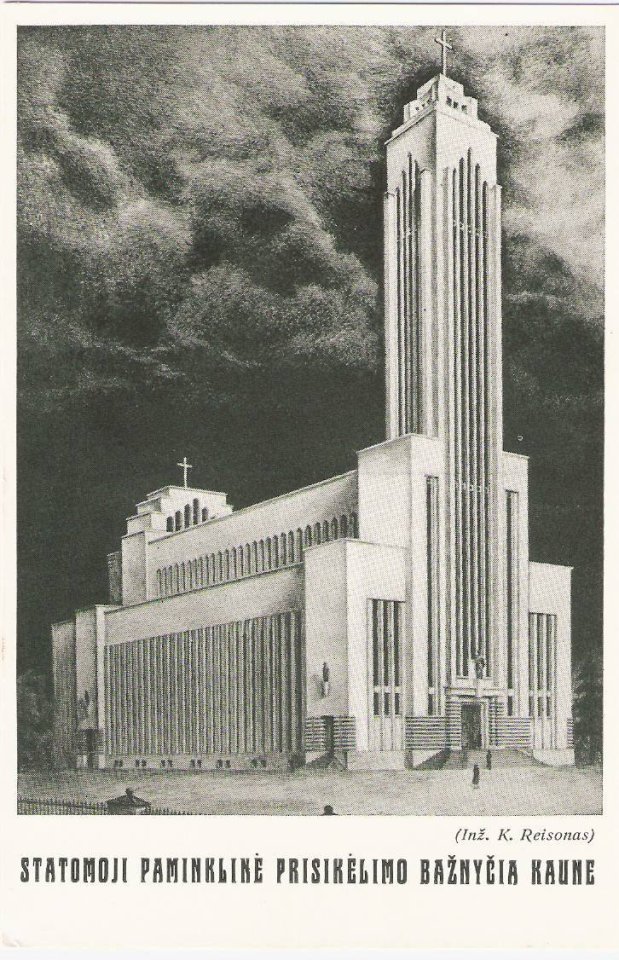
The poster with the “Monumental Church of the Resurrection in Kaunas” from 1940s. | Photo via Lietuva Senose Fotografijose
A lot of valuables were stolen, but the largest damage for the buildings was done by the weigh of goods stored on wooden floors – it crippled the walls, meanwhile the humidity and rainwater which leaked through the holes in the roofs damaged the interiors of abandoned churches. [1]
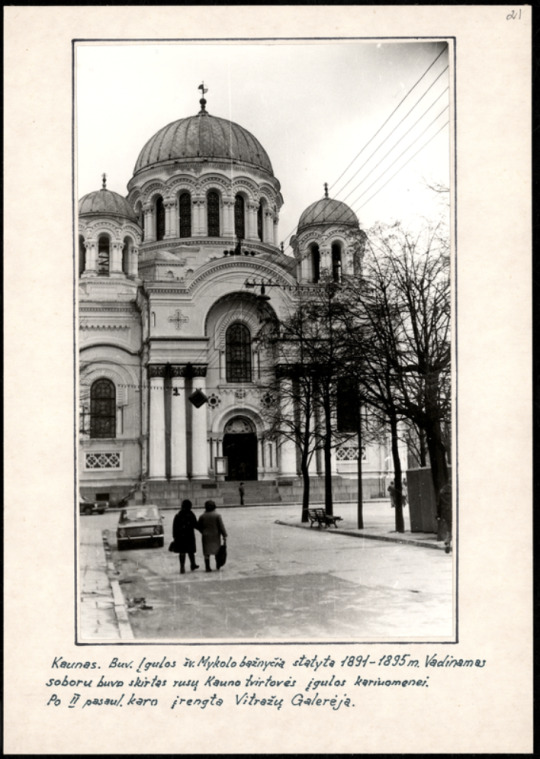
St. Michael Archangel Church was transformed into the Gallery of Sculpture and Stained Glass. | Photo © Nacionalinis Čiurlionio dailės muziejus
A choice to turn a church into a warehouse is rather interesting, since a warehouse had a symbolic meaning in the Soviet Union. Some researchers believe that converting churches into warehouses “was not the abolition of the holy but, so to speak, its replacement. The warehouse is just as ideal an order in the material world as the church is in the spiritual world. The warehouse is a materialist church, but instead of collecting people who are seeking in prayer an exalted form of the soul, it houses a multitude of objects that have found a precise inventoried form.”[2]

Vilnius Cathedral Basilica in 1847 | Lithography via Katedra.lt
Nevertheless, according to various data from 1953 to 1959 nearly 15-20% of churches were closed while some of sacral buildings went through radical transformations. Vilnius Cathedral Basilica (1783) by Gucevičius was closed in 1949. During 1950 sculptures of saints, which were on the rooftop were removed and destroyed. Since the Cathedral was closed a lot of artifacts were stolen while the interior was ravaged. The Cathedral become part of the Museum of Art and was in1956 transformed into a gallery. The building was returned to the Catholic community in 1988.

Vilnius Cathedral Basilica in 1950 | Photo © S. Simanskis
A synagogue of Kulautuva constructed by Trakman (1935) was turned into the warehouse. In 1967−1968 the building was reconstructed and masoned, so that it could be used for a library and a cultural centre.
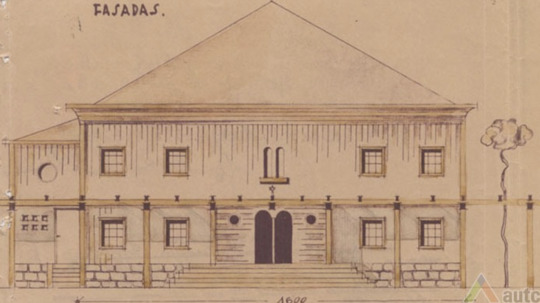

The original constructions of the synagogue were uncovered in 2016 and was due to its poor condition demolished. | Photo via autc
Kaunas and Kaunas District are well-known because of the modernist buildings that were built during the Interwar Period. Five examples of Kaunas modernism – five sacral buildings - that were pushed to the politics of the oblivion in the Soviet times and are celebrated as architectural and cultural heritage today will be presented in this edition of FOMA.
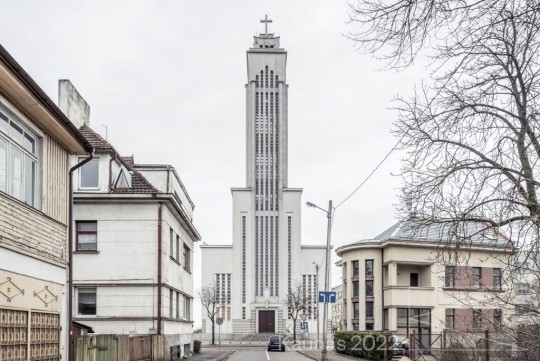
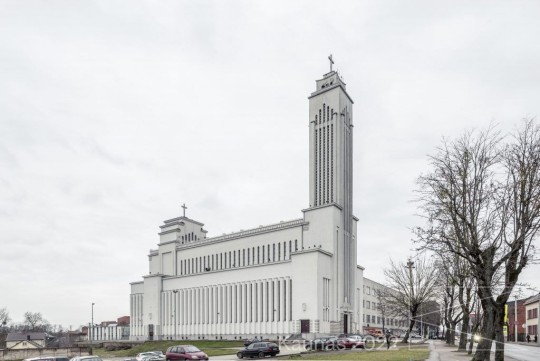
Christ’s Resurrection Church had a flat roof, what was not common for catholic churches at the time of construction. | Photos © Lukas Mykolaitis
The Christ’s Resurrection Church was designed by Karolis Reisonas in 1929 as a 82-meter tall spiral tower crowned by a 7 meter tall statue of Jesus Christ. However, this project was too pricey and not very well accepted by the people of Kaunas, therefore abandoned. A new project was inspired by modernist spirit and designed in 1932. It was believed that the new church would become a monument of XX century architecture because of its contemporary style, advanced construction and quality materials. Its size was also extraordinary and exceptional in the context of the Baltic States.
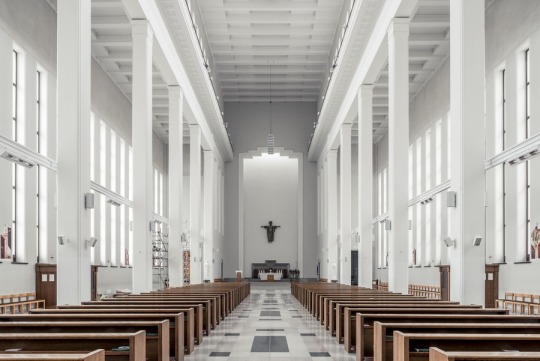

Local granite was used for the construction, and the window frames and doors were made of oak. | Photos © Lukas Mykolaitis
The construction of the church was complicated because of lack of funding. Therefore the community engaged in the collection of donations for the church. In 1938 the walls were masoned and the roof was covered in concrete. In the spring of 1940 main construction works were completed, but when Lithuania was occupied by the soviets, it stopped and the building was confiscated. During the second world war the church was used as a paper warehouse.

The inside of the church was reconstructed, adapting it to the needs of the Kaunas Radio Factory. | Photo © Kauno miesto muziejus
In 1952 a decision was made to turn the church into the Kaunas Radio Factory, later named Banga. The inside of the church was reconstructed, adapting it to the needs of the factory: three stories in the side naves and five stories in the central nave were constructed. Crosses were removed, the chapel was demolished and large industrial windows were installed.

Minija-4 produced 1967-1973 in Kaunas. | Photo © Kauno miesto muziejus
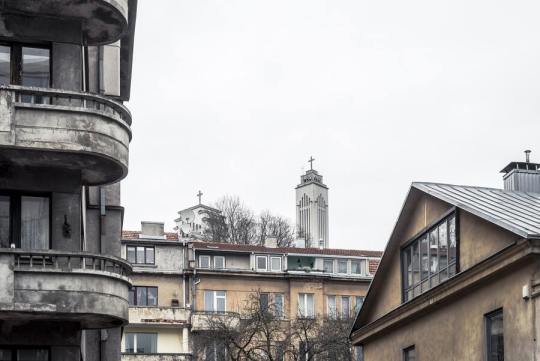
Since the opening in 2004 the church has become the dominant landmark within the cityscape. | Photos © Lukas Mykolaitis
During 1930s Vaclovas Michnevičius designed a neo-gothic church for the Evangelical and Reformed community in Kaunas and the project was not built since its design didn’t fit well with its surroundings.The other project designed by Karolis Reisonas represented current modernist trends with a flat roof, smooth shape and its functionality. Narrow vertical windows added greatness to the image of the relatively small church.

Evangelical and Reformed Church looks similar to Christ’s Resurrection, designed by same architect. | Photo © Skeivys, 1956, KTU ASI archive.
The Evangelical and Reformed Church was finished in 1940 and remained unused due to the Soviet occupation. The top part of the tower was torn down, the building was nationalised and turned into the warehouse for tobacco and alcohol manufacturers. Afterwards was given to the Ministry of Internal Affairs, which adapted it for the use of special school. When Lithuania regained its independence in 1990, most of the churches were given back to religious communities, however, this case was different: since the owner of the building was an educational institution, the rules of returning the property did not apply. For nearly 20 more years the Evangelical and Reformed Church in Kaunas was used as a sports hall and a canteen, until 2019 when the church was given back to the community.
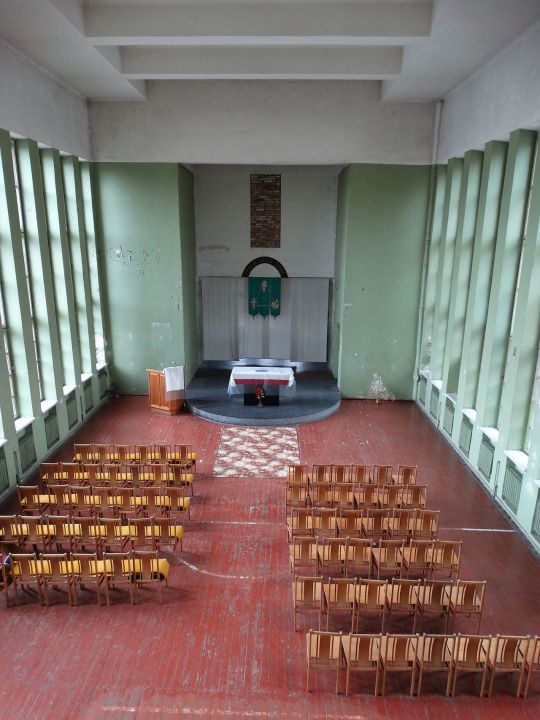
The believers were allowed to pray on Sundays. | Photo Wikimedia
Pažėrai Sacred Heart Church, a masterpiece by Stasys Kudokas, was built in a small village of Pažėrai in Kaunas district. The construction started in 1936 and was funded by the catholic community. The construction of modernist red-brick building was interrupted during the Soviet occupation. In 1967 the function of Pažėrai Sacred Heart Church changed as it was given to a collective farm and used as a grain warehouse.

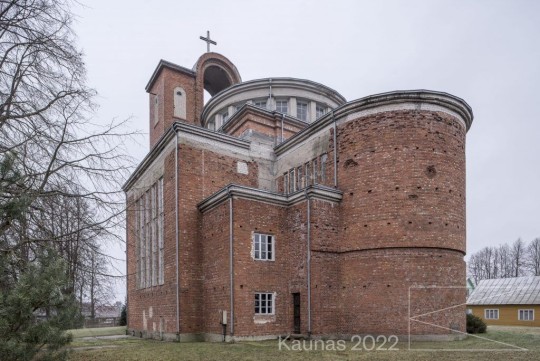

The church has two towers, with a high raised apse and the main space of the building is covered by a dome. | Photo © Lukas Mykolaitis, 2018
When Lithuania regained the independence, the church was returned to the congregation in 1991.The reconstruction began shortly afterwards and in 1997 the nearly-finished church was consecrated. The plan of the church in the form of a Greek cross has an unique, dynamic composition, and it is an example of rational modernist architecture.
Kaunas Mosque also known as Vytautas the Great Mosque is one of four remaining mosques in Lithuania. Its design reminds the mosques in Northern Africa, a compact, small-volume mosque combines historical forms with oriental motifs like an elliptical dome and a small minaret, which was never used for its traditional purpose.
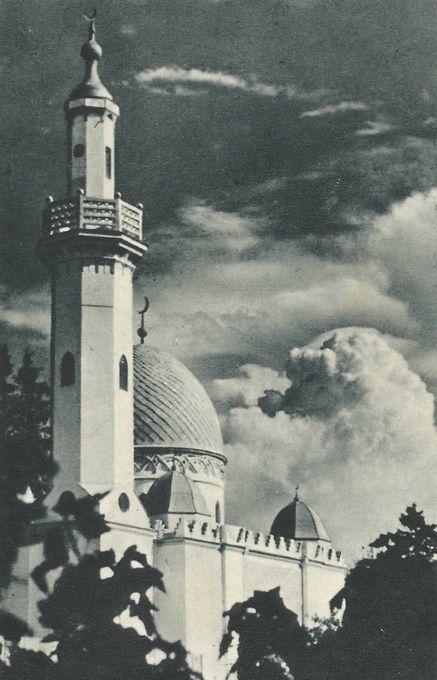
Kaunas had a wooden mosque built in 1860. | Source postcard from 1940s
In 1941 the mosque was closed and robbed: its windows were smashed, carpets, furniture and ancient hand-written Quran were stolen. The ownership rights were transferred to Kaunas City Archive which turned the building into a warehouse. In 1986 the building became a library and a warehouse of M. K. Čiurlionis Museum of Art. During the soviet times murals were painted over and there are plans to recover the old murals by 2030 when the mosque will celebrate its 100 anniversary.
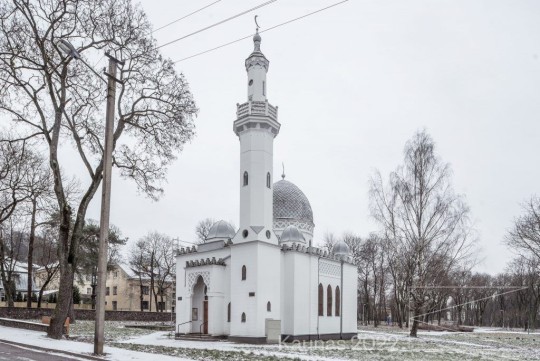
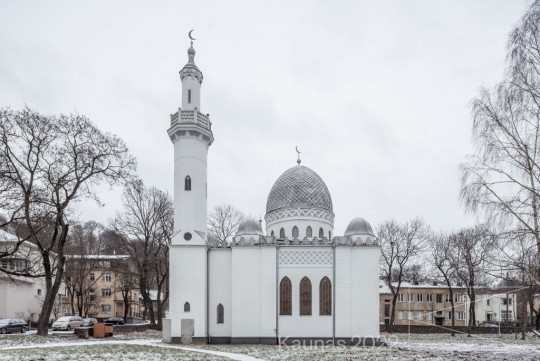
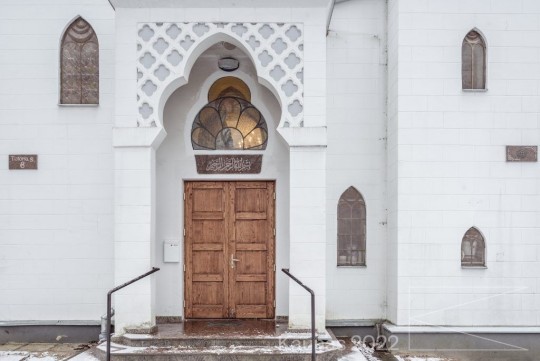
The mosque was returned to the Muslim community of Kaunas in 1989 and restored in 2007-2008. | Photo © Lukas Mykolaitis, 2017
Sacred Heart of Jesus Church in Šančiai neighborhood is a great example of modernist sacral architecture. The church is built of reinforced concrete, the nave is covered by supporting arches and the caisson shell. The exterior is minimalist and composed of regular geometric shapes: square front door and narrow rectangular windows.
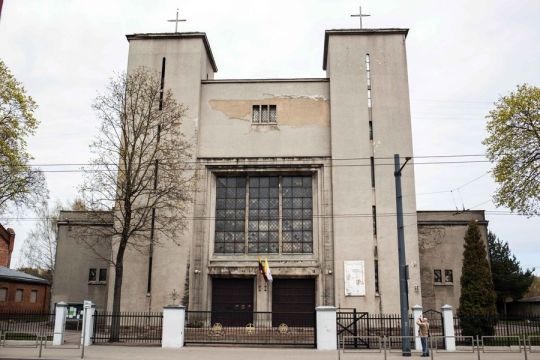
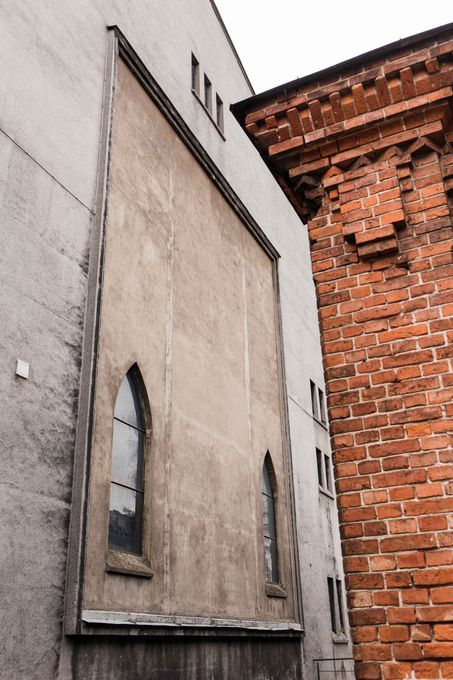
During the war, the church was damaged, instead of stained-glass window a brick wall was built. | Photo © Justinas Stonkus, 2020
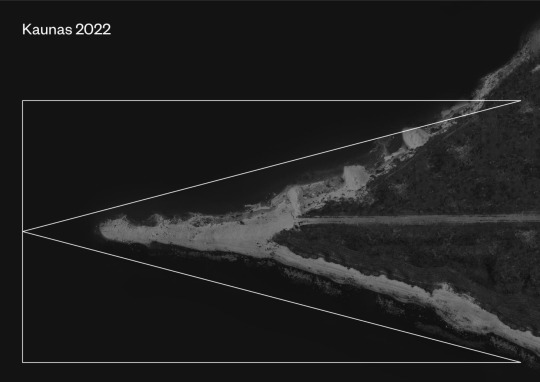
Kaunas2022 European Capital of Culture program Modernism for the Future tackles the questions of preservation, interpretation and dissemination of modernist heritage and promotes various initiatives by building owners, heritage community and cultural organizations.
[1] R. Čepaitienė. Vilniaus bažnyčių likimas sovietmečiu (1944-1990). Liaudies kultūra, 2002/5 (86), p. 32-37.
[2] M. Epstein. Russo-Soviet Topoi. The Landscape of Stalinism: The Art and Ideology of Soviet Space.ed. E. Dobrenko, E. Naiman. University of Washington Press, 2011, p. 301.
—
#FOMA 38: Ugne Marija Andrijauskaite

Portrait photo © Justinas Stonkus
Ugne Marija Andrijauskaite is a historian, who investigates social and cultural history of XX century Lithuania. In 2017 she defended her PhD thesis, which investigated urban workers and organized labour movement in interwar Lithuania. Currently she is working at Kaunas2022 European Capital of Culture program Modernism for the Future. The goal of the program is to awaken responsibility for the environment that surrounds us and create an emotional connection with the urban landscape and culture.
180 notes
·
View notes
Text
Things to Do on Holiday in Lithuania
Holiday rentals are becoming more popular each year in Lithuania. Families come here to stay in self catering apartments of holiday villas and explore the local life and culture. There are many places to see and visit in Lithuania.
If you're interested in castles, cathedrals and culture it's the place to stay. Trakai is known as the town of lakes. There is a huge Trakai castle that was built by the Grand Duke Vytauas Magnum. Inside of the castle is the Trakai History museum. It's very impressive to see the murals, glass stained windows and the invention of the heating system of the Middle Ages.
The Ausros Vartai or the Gate of Dawn is a renaissance building made up of three storeys. While there you can stay in one of the many luxury self catering apartments or holiday homes in the capital. City breaks are extremely popular and tourists rent a holiday villa or holiday apartment direct from the owner. The outside of the Vilnius Cathedral is similar to a pagan Greek temple. This Cathedral has a neoclassical exterior. In the past here the fire God Perkunas was worshipped by the Lithuanians. The Vilnius University was established in 1570. This is located to the North West of the Old Town. During the cultural tour of this city, you must visit St. Anne's Church. This is a very impressive structure.
Many tourists rent a holiday villa and visit the world heritage site of Curonian Spit. This is in the Baltic Sea where there is a long and thin sand peninsula. This found a place in the World Heritage List of UNESCO due to the history of the interaction between landscape and humans. The German architect, Franc Schwechten designed the former mansion of the Tiskevicius family. This was constructed in 1897. Here stands the Palanga Amber museum. The National Museum of Lithuania shows the ups and downs of the modern history of Lithuania. The prime exhibition is situated in the enticing New Arsenal of the 18th century.
Vilnius is renowned for its shopping. In Vilnius, there are huge department stores called the Europa and Akropolis. There is also a huge range of indoor malls, markets and shops. In the old town of Vilnius, there are shops that sell traditional souvenirs, holiday gifts and amber. The most famous souvenirs from this country are the amber jewellery from watches to bracelets. Most tourists choose to stay in self catering apartments or holidays villas and enjoy the shopping, local cafes and restaurants to the full.
Visit Best Restaurant in Vilnius : Click Here
Šventaragio sodas 1,L. Stuokos-Gucevi?iaus g.,Vilnius, 1122 Lietuva (8-5) 208 0805 [email protected] https://sventaragiosodas.lt/ https://www.facebook.com/SventaragioSodas/ https://www.instagram.com/sventaragio_sodas/
#restoranas vilniuje#velyvieji pusryciai vilnius#restoranas sventaragio sodas#restoranai vilniuje#pusryciai vilniuje#restaurant#vilnius
1 note
·
View note
Text
15 Budget Friendly European City - #Austria, #Belgrade, #BosniaAndHerzegovina, #Bratislava, #BratislavaCastle, #Bucharest, #DnieperRiver, #Europe, #EuropeanCity, #Holiday, #Holidays, #Hungary, #Kiev, #Krakow, #Lviv, #LvivOperaHouse, #NikolaTeslaMuseum, #Poland, #Prague, #Sarajevo, #Serbia, #Slovakia, #Sofia, #StPetersburg, #Travel, #Traveller, #Travels, #Ukraine, #UNESCO, #UseumOfYugoslav, #Zagreb
New Post has been published on http://justforustravel.com/2017/10/02/15-budget-friendly-european-city/
15 Budget Friendly European City
in Europe, continues to welcome visitors with historical beauty and cultural heritage in Europe.. Well what are the countries that you can travel with low budget? For the people who are planning to travel, eating, drinking , walking around European cities with the cheapest 15 I looked for you. 15 let’s do this together let’s make this the city.
Belgrade
the capital of Serbia and the Balkans, Belgrade translated into Turkish, the meaning of the White City. The National Library of Serbia in Belgrade, National Theatre and the city’s cultural and art centers. Beer festival repeated every year and the Nikola Tesla Museum, Belgrade is a paradise full travel. The white color doesn’t look too out, but Belgrade nightlife and cheap alcohol… that you can go without a visa, with the possibility of the Balkans in Serbia naughty boy can enter with only a passport, and you can enjoy affordable prices.
where do you go?
The Nikola Tesla museum, cathedral of Saint Sava, Student cultural centers, night clubs, Museum of Yugoslav history
Bratislava
Slovakia’s capital Bratislava and the border to Austria and Hungary and which is one of two cities in the world that has this feature. At the same time, which is one of the production bases in Europe, Bratislava, is in possession of a very famous European brand factories.
where do you go?
The Old Town, Slovak National Museum, Bratislava Castle, Primate’s Palace, Michael’s Gate
Bucharest
established on the fertile soil of the Danube River, an other city, the capital of Romania is Bucharest. Traces of the streets and buildings of that period from the communist era, Bucharest hosts the architecture itself hides. People in Romania spoke fluent English, and many of the stores let me remind that there is no Turkish brands in Bucharest. Lipscani street vendors and mobile shop don’t forget to try the flavors in the part.
where do you go?
The Parliament building, the characters in the park, Revolution Square, National History Museum, Lipscani street
Lviv
Lviv which is the entry point for thousands of tourists every day, it’s quite a young city. The hostel is a young city with cheap food and beer 24 hours a day. And transportation and accommodation according to Turkey, but very, very cheap. Made in the spring of each year in the City Music Festival and Opera Festival repeated every year adds to the intellectual accumulation of the city. I have to mention that were very beautiful girls from Lviv.
where do you go?
a statue of the man in the hat, Muzeje Square, Victorian Tea House, the square, UNESCO World Heritage Site, Lviv Opera House
Kiev
the capital of Ukraine and home to works by Eastern Europe’s most cultural city, Kiev, the Dnieper River on both sides of established, quaint city. In Kiev where you can travel with a full budget to the appropriate student-friendly city.
where do you go?
The St. Sophia Cathedral, Golden Gate Park, Liberty Square, 2. World War II Museum, the Golden Gate
Krakow
Poland’s, which is one of the oldest and largest cities of Krakow, a city known to host the king of. Welcomes millions of tourists every year in Krakow from the Second World War was in ruins, and a city is able to pull himself together. An enjoyable trip in addition to intellectual knowledge with Krakow if you want to return.
where do you go?
florianska street, the Vistula River, Sukiennice, Cathedral Museum, and Wavel Castle.
Prague
the city’s most beautiful and nostalgic Central Europe, Prague. It was visited by hundreds of thousands of tourists every year, and beer, with the remaining from the Soviet era and Nazi breezes to the fullest Prague is a city that you will spend your trip budget friendly. That which is the capital of the Czech Republic with a Schengen visa you can log on to Prague , in the center of divided into zones from 1 to 20; 20. as we went through the region, quite away from the city centre.
where do you go?
The Charles Bridge, the Astronomical Clock, St. Vitus Cathedral, John Lennon Wall, the Franz Kafka Museum.
Riga
among the most lively and most vibrant capitals in the Baltic city of Riga, capital of Latvia. Nightlife Riga with the Baltic culture blended with a heated atmosphere despite the cold life with warm people around. The blonde gene is dominant, and in this country it is possible to see beautiful blondes everywhere. Just lift your head and look around.
where do you go?
karakafali house, Freedom Monument, Riga Cathedral, St. Peter’s Cathedral, TV Tower
Sarajevo
broken’s capital is the heart of the Balkans, Sarajevo, the capital is hosting the blues and the history; you just log in with your passport that you can other Balkan city. You can look for souvenirs in this city, where historic streets able to find flight tickets at affordable prices.
where do you go?
The Old Bridge, Mosque Husrevbey, the tunnel Museum, miljack River, Bascarsija
Sofia
The Sofia valley that was established in the socialist period in both capital and contains tracks from Orthodox traditions. In a short time Sofia is a tourist city that you can visit fun and at the same time. Snow fun in ski resort, in mountain, you can spend a day avito.
where do you go?
The Museum of socialist art, the artist bars, Alexander Nevski Cathedral, studentski Grad, Oborishte
St. Petersburg
which is a city which inspires writing novels Dostoevsky’s St. Petersburg, Russia 2. the largest city and cultural center of Russia. It is possible to see these channels and the channels on each side of the city a special beauty to the city, they add. Known as the gateway to Europe, this city European cities -especially Venice – inspired and claimed that it was created.
where do you go?
The Hermitage Museum, Katherina the great Statue in White Nights Dance Festival, Bloody Church, Peterhof
Warsaw
in the Second World War 80% of which were rebuilt with the help of the Soviet Union This city was destroyed. Poland’s largest city and capital, Warsaw, is a European city that hosts the traces from the Soviet era. Host a student city with a student population full and vibrant night life. As it was in Poland, all in Warsaw , compared to other European cities and between destinations that you can visit for less money
where do you go?
The Old Town in Warsaw, Palace of Culture and Science, Lazienki Park, Nowy swiat street, Prague
Vilnius
as the Lithuanian capital Vilnius, close to the Baltic Sea in the cold weather containing within a closed air. Rather than stay in the center of the city, very near to interesting places in the center of destinations you can visit. Visit Vilnius and get to know enough for 24 hours.
where do you go?
Stikliu street, National Museum of Lithuania, St. Anne’s Church, Uzupis, Museum of Genocide victims
Zagreb
along the Dalmatian coast in Croatia, a country that was founded, which is the most populous city in Zagreb. Streets steeped in history, convenient transportation and the kind of boutique hotels of Zagreb is the capital of Culture. The city will be crowded in the winter while during the summer months with the majority of the population down to the coastal town takes on a silent character.
where do you go?
Zagreb Cathedral, Upper Town, maksimir Park, ban jelacic square, tkalciceva street
*Prices number’is taken from. According to changes in the exchange rates may vary.
#Austria#Belgrade#Bosnia and Herzegovina#Bratislava#Bratislava Castle#Bucharest#Dnieper River#Europe#European City#holiday#holidays#Hungary#Kiev#Krakow#Lviv#Lviv Opera House#Nikola Tesla museum#Poland#Prague#Sarajevo#Serbia#Slovakia#Sofia#St. Petersburg#travel#traveller#Travels#Ukraine#UNESCO#useum of Yugoslav
1 note
·
View note
Photo

http://bit.ly/2HoEnZh #sleepwithus @hotelpacai #lithuania🇱🇹 Set in the heart of Vilnius’ Old Town—home to a university, a presidential palace, and an abundance of museums, embassies, churches, bookshops, and the city’s coolest spots for dining and drinking—Hotel Pacai perfectly echoes this quarter’s 17th-century Baroque grandeur, yet augments it with a contemporary twist. Famous for being the most magnificent mansion in the Grand Duchy of Lithuania, the stately building has been reborn thanks to the inspired efforts of a passionate team of local architects and designers. Rich historic elements are masterfully blended with present-day design to showcase soft, deep tones and elegant materials that heighten the structure’s classical style and complement its relaxing spa. The 104 rooms and suites, the inviting restaurants and bar, and the four meeting rooms all celebrate Lithuania’s rich past and Baltic culture, while also pointing it forward in a direction that is young and vibrant in spirit. Indeed, rounding out the hotel’s world-class offerings is the restaurant Nineteen18, which explores new Baltic cuisine while celebrating the rich culinary heritage of the region immediately around Vilnius. Also intriguing is the hotel’s expansive courtyard, which evokes the atmosphere of the city’s surrounding historic buildings. Here, guests enjoy local art events, dinners that stretch long into the night, and more—making this transformative property a new cultural hub in Vilnius #stayhere #globalsleeps #booking #hotel #holidays #holidaydestination #sleep #relax #instahotel #hoteliers #hotelstyle #hotellife #hotelgram #hoteldesign #bookingcom #besthotel #hotelstay #travelling #vacation #seetheworld #ig_travel #travelguide #traveltheworld #travelgram #lithuania (at Hotel PACAI, Vilnius) https://www.instagram.com/p/Bs7iu4QBMSx/?utm_source=ig_tumblr_share&igshid=mv776uf5gvlr
#sleepwithus#lithuania🇱🇹#stayhere#globalsleeps#booking#hotel#holidays#holidaydestination#sleep#relax#instahotel#hoteliers#hotelstyle#hotellife#hotelgram#hoteldesign#bookingcom#besthotel#hotelstay#travelling#vacation#seetheworld#ig_travel#travelguide#traveltheworld#travelgram#lithuania
0 notes
Text
25 best museums in Vilnius
New Post has been published on https://tripsterguru.com/25-best-museums-in-vilnius/
25 best museums in Vilnius
The Republic of Lithuania is located in the northern part of Europe. It is famous for its mild climate, comfortable hotels and excellent cuisine. Those who like to soak up the sun can fully enjoy the beautiful beaches and gentle waves of the Baltic Sea, go surfing or find other water activities. Those who prefer city walks – at their service – the old city of Vilnius. Holidays in Lithuania will appeal to many travelers. In this small country, modernity and antiquity are closely intertwined. There you can see beautiful landscapes, castles, many cafes that serve national cuisine, temples and of course – Vilnius museums.
Radziwill Palace
The city has one of the most beautiful castles in the country – the Radziwill Palace. This is a business card not only of the city, but also of the country. It is built in the style of the late Renaissance. Previously, in its place was a wooden palace, but it was damaged during the fires. In the mid-17th century, it was rebuilt by architect Jan Ulrich.
In 1807, the building was transferred to the Humanitarian Society. Since then, the building has been repaired many times, some parts have been completely destroyed, and new buildings have been built in their place. Today, the northern and eastern buildings and the pavilion have been preserved from the palace ensemble. In 1984, the architect Evaldas Zulonas prepared a project for the restoration of the western pavilion, according to which it was completely restored. In 1990, the building was restored, and after that, a unit of the Lithuanian Art Museum of the Radziwill Palace was placed there.
It stores unique paintings by artists from Germany, Austria, Russia, France, Holland, Poland. In addition, there is an exposition dedicated to the Radziwill family. It consists of patrimonial portraits and photographs, icons, archaeological finds. In one of the buildings the art of the peoples of East Asia is kept.
State Jewish Museum of Vilnius Gaon
The Republic of Lithuania is not rich in single ancient castles. Of great interest is the State Jewish Museum of Vilnius Gaon. It consists of three different organizations, united into one whole cultural space – the Litvak Cultural and Art Center (Jews living in Lithuania), the Tolerance Center and the Holocaust Exposition.
In 1913, its very first branch was opened. Relics of Jews, privileges granted to Jews by local princes, letters were kept there. When the First World War began, the organization was temporarily closed. Her work resumed in 1919, in a new building. The building was destroyed during the Second World War, and they began to rebuild it in 1949. Collections previously stored there were scattered around various institutions, and it was worth a lot of effort to assemble them again.
The institution fully resumed its work only in 1989. In addition to the valuables previously stored in the center, it stores materials, documents, photographs taken during the Holocaust, and miraculous evidence of surviving Jewish witnesses. Also, there is an exposition dedicated to the Jewish life of the late 19th, early 20th century.
National Museum of Lithuania
It belongs to the largest institutions where the cultural heritage of this country is collected. It was founded in 1855, on the initiative of Count Eustathius Tyszkiewicz – a zealous collector of antiquities and the study of antiquity. His efforts brought together unique collections. The institution is located near the Neris River, in the heart of the capital. After opening, this place became a cultural and scientific center.
The intelligentsia and the nobles gathered there, conducting educational and scientific activities. Their goal was the formation of historical identity, the establishment of cultural memory. The activity of the complex was interrupted several times. His full-fledged work was resumed only in 1952. Now, more than a million different exhibits are stored there that demonstrate the centuries-old development of the country and its cultural heritage.
There are departments devoted to numismatics, archeology from the Middle Ages to the present, iconography, and ethnic culture. It intertwines antiquity and new technologies. Systematically, the building hosts virtual thematic exhibitions dedicated to famous figures of the country or documentary photography. And you can get acquainted with the history and culture of the country by attending Thursday meetings held weekly.
Museum of Energy and Technology of Lithuania
It will appeal to everyone who loves history and technology. Its building is located opposite Gediminas Mountain, on the banks of the Viliya River. This place offers a magnificent view of the local landscape. For a long time, the building was abandoned, and only in 2003, the first exposition was opened here.
It was dedicated to the centenary of the opening of the first power station in the country. The exhibits presented in it tell about the history of electricity. Since then, the institution has replenished with new exhibits. For children, a special excursion to a real old power station is offered. They can become active participants in the process. Many parts of the station are replaced by mock-ups that create an imitation of a real workflow.
On one of the floors there is a collection of rare cars and motorcycles. There are models of almost a hundred years ago and instances of the 60-70s. In a separate exhibition hall, samples of items made in workshops from the Middle Ages and the Soviet period are exhibited. All exhibits are allowed to be touched, and for lovers of modern technology there is an interactive exhibition.
Church Heritage Museum
Initially, it was a monastery with a church, built by order of the Lithuanian hetman Sapega. The crypt of the temple was to be used as a family crypt. The best Lithuanian and Polish architects worked on the construction and decoration of the church. Under the monastery, Leo Sapega gave one of his palaces. The temple was rebuilt several times.
It has distinguishable features, both Gothic and Renaissance. Of interest is not only the building, but also the unique church items stored inside it. Church services ceased to rule in the last century. In 1970, a museum was opened inside, which presents real masterpieces of church art. Many objects are made by famous masters of Western Europe of the 18-19th centuries.
There are relics for storing relics, church utensils, pectoral crosses, gold and silver containers for holy water, precious portiers and salaries, icons. In the courtyard, you can see a large collection of bells. The altars of the church are made of alabaster and multi-colored marble. Each thing has its own, by and large, tragic story.
Lower castle
Initially, immediately after construction, the Lower Castle was part of the complex, including the Lower Castle, the Cathedral, the services of the palace, and utility rooms. The complex was built at the foot of Castle Hill. The construction of the castle began in the first half of the 14th century. And already in the middle of this century the palace became the residence of the Lithuanian prince.
In the 16th century, the Grand Palace was built, in which at one time the Lithuanian princes lived. It was built in the Renaissance style. The palace complex was significantly damaged during the war with the Moscow state, and with the expansion of the city, in the 18th century it was almost completely destroyed. The palace was recreated again only in 2002. Now, in the new castle is a museum where historical artifacts are stored. From the old complex, only the western tower remained.
At its base, a bell tower was erected with a height of 57 m with an observation deck for tourists. It offers magnificent views of local attractions and beautiful landscape. The institution was visited by leaders from 15 countries during its opening. Various events are often held there. It is noteworthy that in this palace, for the first time in Europe, the opera was performed.
Museum of Applied Arts
The building of the old Arsenal was built on the ruins of an old defensive complex of the 14th century. From it, at the time of the construction of a new building, from the old buildings there were only walls and a foundation. They were taken as a basis during the construction of the Arsenal. For two centuries, the building was used to store weapons and ammunition. After the reconstruction of the city, the building turned out to be on the central city street. They did not begin to demolish it, but called the best architects from Italy to rebuild.
So the warehouse turned into a real palace, which the Queen of Vilnius used as her residence. After the country was divided, part of it became part of the Russian Empire, they forgot about the Arsenal. The building was partially restored only in the 19th century. It was completely restored only in 1972. Now, there is a museum of applied art. In 1987, it hosted thematic exhibitions dedicated to Lithuanian applied and sacred art.
From time to time there are exhibits from Europe and the USA. At the moment, there you can see various old household items, furniture, jewelry, ballpoint notebooks, jewelry boxes, clothes. Collected artifacts were made in the period from 13 to 20 tbsp. A workshop has been preserved on the territory of the Arsenal, which everyone can visit.
Museum of Modern Art of the MO
The opening took place in 2018. And the building was erected a year earlier. A private institution was built instead of the cinema, which was here before. The institution is financed by businessmen Victor Butkus and Danguole. The planning of the building was carried out by the architect Daniel Libeskind. In total, the house has three floors.
On the ground floor there are lockers, a bookstore, a universal hall and a cafe. The second consists of several rooms – a small exhibition hall, administration rooms and a reading room. The top floor is occupied by a large exhibition hall. There is an open terrace on the roof of the building, and there is a square near the building itself. The institution often organizes exhibitions, cultural, artistic and educational events.
Employees of the MO are engaged in the implementation of various creative projects in the capital. Over 100 contemporary artists collaborate with the organization. Through the efforts of the MO, a guide to the sculptures of Vilnius was prepared. This is the only traveling museum that travels around the country’s schools. The institution belongs to the ten best museums of our time, which must be visited.
Lithuanian Museum of Theater, Music and Cinema
Located in one of the old Radziwill mansions. The building, in its time, has seen many luxurious balls, receptions arranged there. In its architecture traces of several styles have survived – Renaissance, Baroque, Classicism. The first Lithuanian private theater, which belonged to local tycoons, found refuge here. For a while, the palace was empty, and then it was divided into apartments and rented out. After the end of World War II, there was a back room of the capital’s theater. The Radzivils mansion was completely restored only in 1996.
Now, in this magnificent mansion is a museum of theater, music and cinematography. It contains unique artifacts that shed light on the development of cinema in the country. The exhibits were kept in wartime in the former capital of Lithuania – Kaunas. Some of these artifacts were reassembled, but some were lost forever. The exposition consists of four parts. This unique collection has tickets, scenery layouts, costumes, posters, play scripts. Of great interest is the collection of old dolls, collected from all over the country, through the efforts of enthusiasts. Here you can collection of paintings and even old musical instruments.
Lithuanian Railway Museum
Each country has its own history of the development of railways. The idea to create a place that will acquaint visitors with the life of railroad workers appeared in 1966. Then the museum was opened. A large photo archive was collected in it, demonstrating the everyday life of the railway employees of that time, layouts. Institution, in 2010 it was closed for reconstruction. Now, the exposition occupies a space of 800 sq.m. It was divided into three separate zones.
In the first, various events are held, train models are demonstrated. For visitors with children organized a children’s corner. In the open air there is another exposure covering an area of about 1 hectare. There are models of steam locomotives, electric locomotives, diesel locomotives, maintenance equipment. Here you can see the first Soviet train “Sergo Ordzhonikidze”. Such was the first model of a special train that arrived in the post-war time in Germany (1945).
Here you can see the first German locomotives of the TE-52 series. In these locomotives everything was thought out to the smallest detail. Near the exhibits there is a retro display, which was used in the old days to notify the arrival or departure of trains. This line is rarely used. The last time it was opened in 2017 for commercial purposes – a fashion show and a design exhibition.
Museum of Genocide Victims
In wartime, crimes against individual nations were common. After several decades, evidence of this by the miracle of eyewitnesses surviving in those days, archives of photographs, documents still remind of this. The walls of the building managed to see many terrible crimes. The building was built in the 19th century. for the court of justice.
Then, there was a recruiting station. A few years later, the Bolshevik prison of the revolutionary tribunal was located within these walls. Owners changed only in 1920. The building, after the division of Lithuania, went to the courts of the Polish government. In 1940, this house belonged to the NKVD, and in wartime it was occupied by the GESTAPO. After the war, for a long time, the building was occupied by the KGB. Such a long history made this building the most sinister in the history of this country.
Genocide displays are located in the basement. Many exhibits tell the history of the country at different time periods. On the second floor, the exhibits acquaint visitors with the period of the deportation of Lithuanians in 43-55, the activities of the KGB, and civil resistance. Here you can see samples of listening equipment. Nearby is the premises that the KGB used as a prison.
Art Museum
It was founded in 1933 and consists of several branches. It exhibits many cultural and historical values. There you can see the work of both Lithuanian and foreign masters. The institution includes a branch of applied art, the Gallery of the artist Pranas Domšaitis, watch museums and miniature arts.
The first branch exhibits such exhibits: tombs and crayfish made by goldsmiths, woven belts, clothes with embroidery, tapestries, porcelain from Sevre, Vienna, Meissen, amber items, metal objects, furniture, Czech glass. The gallery fund is constantly updated with new collections of local and foreign artists of Lithuanian origin. In addition to paintings, there are exhibits introducing visitors to the development of graphics, sculpture, and painting in the country.
The room contains parts of the interior of the palace. The next branch presents a collection of watches manufactured at different times (from the 16th to the 20th century). A fragment of the park, which was here in the 19th century, is located near the institution. In the branch of miniature arts you can see fans of antiquity, bead embroidery, wallets, elegant boxes. Nearby is the gallery of Pranas Domšaitis. It exhibited the work of artists, sculptors, graphic artists from Western Europe, more than 500 works of Pranas Domsaitis himself.
House of Signatories
House of Signatories in 1917-1918 belonged to the Council of Lithuania. It was there that the historical document on the restoration of independence of Lithuania was signed. Signatures that became diplomats are stored there. The exposition is in a separate room. The items stored there acquaint visitors with the beginning of the national revival in the 20th century. and the formation of statehood.
In 1795, most of the country went to the Russian Empire. There was no longer a country like Lithuania on world maps. The country gained independence only during the occupation of territory by Kaiser Germany. The central and most important exhibit is historical material, demonstrating the long way of Lithuanians to independence.
The building is now attributed to the architectural and cultural monuments of the state. It was built in 1645. The owners of the house were constantly changing, and the building was being renovated. At first, the house consisted of two floors, but after the fires, during its restoration, another floor was completed. In the 19th century, after restoration, in the exterior of the house, the Neo-Renaissance style began to be seen. The house is of great architectural value. On the main facade you can see beautiful sculptures in niches, busts of men.
Toy museum
The expositions of the institution include many exhibits obtained by archaeologists, private collections of collectors and visitors donated. In this place, both children and adult visitors will find a lot of interesting and informative for themselves. Of great interest are toys of the Stone Age and the Middle Ages. They were found by archaeologists during excavations.
Children can touch quality copies of these items. There are different models of dolls, balls, board games of nobles. The exhibition has a section that introduces visitors to children’s toys and games of the 14-18th century, found in the country. Near most exhibits there are fragments of paintings by famous artists, which depict a toy in action. The funs found in Lithuania can be seen in the works of Jan Vann Eyck, Bosch, Peter Bruegel.
In addition to old exhibits, there are samples of modern, high-tech fun. There are collections of soldiers, dolls, gaming machines of the 70-80s. In a separate room (workshop), events are often held where employees of the institution introduce everyone to the history of wax, the first toys. All this is accompanied by a master class.
Art Museum of Vytautas Kasiulis
Vytautas Kasiulis is a well-known artist in Lithuania. His works are known far beyond the borders of the country. They adorn the galleries of the best museums in the world. Many critics consider him one of the best representatives of modern art belonging to the French school of painting. Over the entire life period, Kasyulis painted about 1,500 oil paintings, 50 lithographs, completed 950 works with pastel and 200 with gouache. All works are of great value to the entire world community.
The gallery has 950 paintings by the artist. All of them are written in a different period, which is displayed in a variety of colors, the nature of the plots. The peculiarity of the paintings is the brightness of the colors. They have everything – a riot of colors, interesting storylines, both real and absolutely fantastic. The institution has collected works from different periods of Kasyulis’s life.
In addition to paintings, the artist’s personal belongings are transferred here, transferred to the fund of his widow. It is located in a historical place – a palace of the neoclassicism period, built at the beginning of the 20th century. In addition to the gallery, the palace has a library, archive and meeting rooms for members of society. In 2012, the building was reconstructed with funds from the European Regional Development Fund.
Bank of Lithuania Money Museum
The exposition belongs to the Lithuanian state bank. The exhibits are located in five rooms, on two floors. The exhibits exhibited there tell the story of the origin of the money of this country. There are means of payment that were used to pay for goods when money had not yet been invented. Such products include sable skins, pieces of silver and bronze.
Each of the collections shows how money evolved, from the time when it was not, ending with modern means of payment. Several rare coins of great value to numismatists are stored here. The most valuable exhibit is 10 gold ducats.
They were minted back in the days of the great Lithuanian prince Sigismund Vasa. The coin was previously in a private collection, and was purchased by the bank for 134 thousand euros. In addition to coins, there are many interesting copies of paper bills – 1 thousand trillion Zimbabwean dollars, household items decorated with coins, treasures found in the country, machines for counting bills of different periods of issue, documents telling about the establishment of banking.
Gediminas Tower
It is difficult to find a better place than Castle Hill for the construction of a defensive complex. The mountain is surrounded by rivers on all sides. The first settlements on its territory appeared in the Neolithic period. Then, around the 11th-13th centuries, the first defensive structures were erected here and a wooden castle was built. A little later, the Upper Castle was erected in its place.
When the Gediminas dynasty came to power, the Upper Castle became the main political center of the Grand Duchy of Lithuania. The defensive complex included Krivoy, Lower and Upper castles. He repeatedly repelled the attacks of the Teutonic Order. In 1419 the castle was destroyed by fire. It was restored, but instead of wood, stone and brick were already used for construction. To date, only the West Tower has remained of the complex of structures.
The building is considered a valuable heritage of the country. Gothic style prevails in architecture. The tower rises 142 m above sea level. It has the shape of an octagon, and consists of three floors. On the premises of the tower is a museum. In it you can see models of Vilnius castles, archaeological finds, knightly armor, weapons. In the territory where the tower is located, there is still a preserved part of the walls of the Upper Castle.
Vilnius University Museum of Science
Vilnius University has a very long history. Its founder was the Polish king Stefan Batory, in the 16th century. In the Republic of Lithuania, it is one of the main higher education institutions in the country. It is not only of historical value. The university is part of the architectural ensemble, which is located on the territory of the old city.
The institution consists of 13 buildings and 13 courtyards. It is noteworthy that during visits by the heads of foreign states to this country, the university is an obligatory place for visiting by the delegation. On the territory of the institution there is a church, several museums, which display expositions of paintings, sculptures, numismatics, rare books on philosophy, ancient editions of the Bible. The buildings were erected at different times, and this was reflected in their appearance. There you can see Gothic, Baroque style.
In the Gothic style, the church of St. Ioanov – Baptist and Evangelist, included in the architectural ensemble of the university. Then, after restoration, in a later period he acquired all the signs of Baroque. This is especially pronounced in the chapel of St. Anna, which currently houses the science museum. It contains many valuable samples, and the interior is striking in grace and luxury.
Literary Museum of A.S. Pushkin
The great poet never visited this country, and despite this fact, there are more than enough reasons for opening the complex. The institution is located in the former mansion of General Melnikov, who became famous in the wars of the early 19th century. This estate was inherited by the daughter of the general, who, after the collapse of her previous marriage, moved to live in St. Petersburg.
There, a woman met with the poet’s younger son, and soon the couple got married. After marriage, the newly-married couple spent some time in Markuchai, then settled in the family estate Mikhailovskoye. They lived there a little more than 5 years. In 1899, the estate was sold to the treasury of the Academy of Sciences. So, the couple again ended up in Markuchai. The son of the great poet, Grigory Alexandrovich, devoted the rest of his life to the study of the inheritance inherited from his father.
At his disposal were transferred personal belongings of the poet, manuscripts, family heirlooms, and even drawings. After the death of Grigory Alexandrovich, his widow began to arrange poetry evenings in the house, was engaged in educational activities. Before her death, the mistress bequeathed her estate to the Vilnius authorities. After her death, in 1940 the literary museum of A.S. Pushkin. It has three different expositions – one is dedicated to the life of the poet, the second consists of his personal belongings, and the third includes drawings.
Museum of Illusions
This is a place to have fun. The rooms occupy about 400 sq. M. There is a fun and good-natured atmosphere created by the staff of the institution. There are several different programs – for children of different age categories, adolescents and adults. The permanent exhibition is represented by a number of scientific inventions, physics, optics.
You can see mysterious works of art and various kinds of puzzles. Thanks to interactive technologies, you can paint with light, create shadows and turn familiar things upside down. The visitors are presented with an original collection of ridiculous and unnecessary things, called “Absurdity.” They appeared almost simultaneously with useful things and objects. The second collection of an interactive exhibition immerses everyone in a world where inventions are shown, without which it is impossible to imagine the life of a modern person.
During excursions it is allowed to take pictures, and guides will tell stories about a particular subject, art. Annually, new exhibits replenish collections. A friendly team is working on new artistic solutions, engaged in research of the world of science and art. In the institution, each visitor will find something interesting and informative for himself, and modern technology will help in this process.
Amber Museum
The Baltic Sea gave the country a unique treasure – amber. This transparent, sun-colored stone has been valued for centuries. There is evidence that he was delivered by sea to the court of the Roman emperors. The building is a small-sized house that was built around the 17th century. At first, it was the mansion of a wealthy Lithuanian merchant.
When the Baroque style came into fashion, the house was slightly rebuilt. The facade has preserved Gothic elements, although it has more baroque details. The guides at the institution introduce visitors to interesting legends of this region, tales related to amber, and funny stories. The largest stone that has been found in the country weighs almost 4 kg. There are stones with various inclusions – a prehistoric mosquito, various flies, a grasshopper’s foot.
Another collection consists of rare colored stones. There are more than 500 stones found by archaeologists during excavations. In addition to amber, the vaults of the basement, with ancient masonry and a medieval oven, designed for firing ceramic tiles, are of value. On the top floor there is a shop selling natural amber souvenirs. Each product is provided with a quality certificate that protects it from fakes.
Adam Mickiewicz Museum
Included in the architectural complex of Vilnius University. It is a unique architectural monument of the 17-18 centuries. Initially, it was a merchant’s house. In the 19th century, Zhitsky became the owner of the building. At that time, Adam Mickiewicz lived in an apartment on the ground floor. It was here that the great poet worked on the famous poem Grazhina. This house also housed the Society of Friends of Science, and in 1911, one of its members bought the building. The mansion was restored, and a museum was organized in the rooms where Miscavige lived.
In the late 30s of the 20th century, the building was transferred to the ownership of the Department of Classical Philology of Stephen Batory University. The complex worked until the outbreak of World War II. When the occupation began, part of the exhibits was irretrievably lost. In 1955, Miscavige’s memorial apartment was restored and opened to visitors. The opening was timed to the centenary of the death of the poet. The exposition consists of some of Mitskevich’s personal belongings, the chair on which he liked to sit, a table and about 200 other exhibits — manuscripts, medals, lifetime editions of his works, letters of philomats, sculptures and portraits.
Samuel Buck Museum
Samuel Buck was born in 1933 in Vilnius. Artistic talent began to manifest in him from early childhood. His very first works saw the light in the Vilnius ghetto when he was only 9 years old. After the execution of his father, the boy and his mother found refuge in the Benedictine monastery. In this they were helped by one of the nuns – Maria Mikulskaya.
In 1944, the Soviets freed the Jews in the camps. After which, Samuel and his mother, along with other Jews, left the Soviet Union. Until 1948, they were in Germany, in camps for the displaced. During this period, the painting “Mother and Son” was painted. In Munich, he had the opportunity to study painting. A little later, the family was repatriated to Israel, where the young artist graduated from the Bezalel Academy of Arts.
The Samuel Buck Museum is the only place that is completely dedicated to the work of this great contemporary artist. The exhibition of works was opened in 2017. The artist himself, who currently lives in the United States, also arrived at this event. The complex was transferred 54 works. After the gallery opened, Buck held a painting workshop. In the near future it is planned to create another space for expositions.
Vilnius picture gallery
A collection of works covering a period of more than 450 years will surprise visitors. The gallery is located in the old estate of the Khodkevich family – one of the oldest aristocratic clans in Europe. Among the family members there were many military leaders, cultural figures, diplomats, scientists.
Their estates and palaces could be found in many European countries. Vilnius residence was considered the most beautiful, in architectural terms. It was built in the style of late classicism. Today, an art gallery is located within the walls of the residence. The exhibits were paintings by Lithuanian artists. The exposition occupies four floors of the palace. In many rooms the stucco molding adorning the ceilings, expensive art parquet, famous masters, and a tiled stove were preserved intact. All paintings exhibited in the halls are divided into themes.
Separately exhibited portraits of aristocrats, in a separate room are landscapes and genre painting. Many masterpieces of Lithuanian painting were scattered in private collections of local nobles, and only recently they were able to collect and place them in a gallery. Many of the paintings belong to the masters who studied painting in Germany, Italy, performed church orders.
Artillery Bastion of the City Defensive Wall
The artillery bastion was built by the Lithuanian prince Alexander, after numerous requests from citizens. In 1506, the construction of the wall was completely completed. The need for construction was dictated by a large number of external enemies and the threat of invasion.
In the 17th century, the wall was reinforced with a bastei, which was a brick and ground fortification. In fact, it was a fortification consisting of an observation tower, artillery unit and tunnels. During the war with the Principality of Moscow, the bastion was badly destroyed. In the 19th century, it was covered with earth, and the area around it was turned into a city dump. The artillery bastion was rebuilt by the Germans during the First World War.
The arches were strengthened, the floor was concreted, ventilation was made. When the Second World War began, the structure served as a bomb shelter and an armory. The walls were completely reconstructed and rebuilt in 1965-1970. An exposition of weapons and parts of fortifications were placed on the premises of the bastion. There are exhibits from ancient times to the 18th century. The complex now consists of an original tower built in the 16th century, a wall, rooms for guns and a corridor connecting the buildings to each other.
0 notes
Text
When looking for new places to visit in a country, national parks are always a safe choice. That at least was my reasoning behind choosing to visit Aukstaitija National Park in Lithuania. Having had good experiences with other nature destinations in the Baltics, including Lithuania’s Curonian Spit, I was keen to see more. So even though I didn’t know what it was like to hike Aukštaitija National Park, I set aside a couple days after revisiting Vilnius to find out.
Just an easy bus ride from Lithuania’s capital. visiting Aukštaitija National Park seemed like a fun experiment. Having already experienced most of the well-known destinations in Lithuania, I wanted to dig a little deeper. What I found was a huge national park brimming with idyllic scenery and cultural curiosities. Aukstaitija feels like the kind of place that only Lithuanians will visit and is unfortunately lost on international travellers. But if you’re at all curious, here’s what you can expect.
Aukštaitija National Park
To understand why hiking Aukštaitija National Park is such a great experience, let’s look a little at what makes the national park so special. Lithuania is home to just five national parks, but Aukstaitija was the country’s first national park estabished in 1974. Considering the park’s incredible natural landscapes and deep cultural heritage, it’s easy to understand why. While the park is vastly covered in forest, it is actually Aukstaitija’s 126 lakes that really define it. While fairly flat, there are some hills in the national park that really let you appreciate this huge expanse of wilderness in northeastern Lithuania.
The cultural heritage of Aukstaitija is not to be understated either. Across the national park you’ll come across places that highlight different parts of Lithuanian culture. There are six different ethnographic villages, one of which is a cultural reserve. Then there are traditional wooden sculptures, churches, mills and several museums. One of the park’s most popular spots is the Traditional Apiculture Museum on beekeeping, but sadly that is on the far side of the park from where I explored.
Despite all that is has going for it, Aukstaitija National Park isn’t too popular with international tourists just yet. People likely choose to visit Trakai Castle or Kaunas instead from Vilnius as they’re more well-known. That tends to line up with the fact that there isn’t much English information available online. I went without much information, not knowing where to go or how to get around. Also, since I was getting about on foot and public transport, there were limits to how much of the national park I could see. So below is just some of what you can experience while visiting Aukštaitija National Park.
Ignalina Lakes
Before we get to my trip through Aukštaitija National Park, it’s worth paying some attention to the town of Ignalina. Sitting right on the edge of the park, Ignalina is often people’s main base for exploring Aukštaitija. While you could just use Ignalina as somewhere to sleep and eat, that would mean missing its idyllic rural setting.
North, west and south of town you’ll find some exceptionally beautiful lakes that look straight out of a watercolour painting. Lakes to the north like Palaukinis are simply stunning, with little piers and boats along their shores. Visiting these picturesque lakes before even entering Aukštaitija National Park, meant that I was even more excited to see what the national park had to offer.
The Town of Paluse
To really start your trip to Aukštaitija National Park, you first need to get to the town of Palūšė. Just a couple kilometres down the road from Ignalina, Paluse is where you’ll find the Aukštaitija National Park Visitor Centre. Here you can get all the information you need to plan out your day. There are maps with the park’s lakes and trails clearly shown, as well as bus timetables and information pamphlets.
But Palūšė is more than just home to an information centre. The town is perched down on Lake Lusiai, one of the national park’s largest lakes. Wandering down to the lakefront you’ll find some fantastic views across the lake, as well as a little public beach. As for sights in the town itself, the most important landmark in Paluse is St. Joseph’s Church. Built entirely from wood with just an axe, the church and its interesting bell-tower date back to 1750.
Hiking Aukstaitija National Park
With Paluse the starting point of the hike, let’s actually get to the hiking part of this hiking article. There are many different options for hiking through the national park, but this is what I did. Starting in Paluse, my trail lead me past Meironys around Asalnai Lake and up to Ginucai. All up that walk amounted to between 8 or 9 km, with a few kilometres extra at either end. So while it was a fair bit of walking, it’s certainly not too much for a single days hiking. Walking back would have been hard but not entirely impossible.
Setting out from Paluse, you first skirt around its public beach and head onto a trail through the undergrowth. Walking right by the waterfront you’re constantly getting to admire Asalnai Lake and spot boats here and there on it. Not long after starting on this trail you’re treated to a little outdoor gallery of sorts. Staged along the trail is a collection of traditional wooden sculptures that highlight different local legends from the region. To me they kind of looked like totem poles, but apparently they’re more meant as warnings than anything necessarily spiritual.
Also neat were a set of tree carvings that I spotted further into the forest. Carved into the bark of the trees were shapes that almost looked like feathers. I never found information on them, so they remain a nice little mystery to me.
Anyway, back to the hike. Following the trail north of Asalnai Lake you soon reach the village of Meironys and actual made roads. It’s a nice change of pace switching from forest to more of a country village and something this hike does well. Between Paluse and Ginuciai you change environments over and over, so the scenery never gets boring. That being said, Meironys is the last village until the end and where the good roads end. I did see one couple cycling around that day and they definitely slowed down a bit once the gravel road began.
Other than forests and country villages, the other terrain you encounter is fairly open grassland fields. That being said, this kind of farmland is mostly just before you arrive in Meironys and also Ginuciai. While maybe not as interesting as the lakes and forest, I did manage to stumble across a deer in the fields, one of my rare animal sightings. The one nice constant regardless of the terrain is that this walk is incredibly flat. There definitely are small hills in the national park, but this trail mostly avoids them. It’s gentle as can be, which makes the walk not only pleasant but quite accessible.
Ginučiai
Having finally reached the endpoint of my hike at Ginuciai, it was time to see what this village had to offer. Ginuciai isn’t all that large understandably, so don’t expect many sights to see. The main landmark in the village, besides the surrounding lakes, is the Ginuciai Watermill. One of six historic watermills in Aukstaitija National Park, the Ginuciai Watermill is almost 200 years old. Still boasting its original equipment, the mill was used not only for flour but for electricity too.
The other place in Ginuciai I’d recommend is the Ginuciai Castle Mound, a short walk from the village. Many castle mounds and ancient settlements are scattered through this large national park, but this one is recognised as one of the most important. While there isn’t a castle or fortifications there now, the Ginuciai Castle Mound was used during the 9th to 12th century and possibly later. Castle mounds like these were used to fight the invading Teutonic Order, who you’ll also hear a lot about in places like Cesis in Latvia.
Even though there aren’t any real remains at the castle mound, it’s still worth the visit. Standing at the foot of the mound, it’s obvious how well-defended the spot would have been given its height. Once you reach the top though, you’re treated to some phenomenal views of the lakes of Aukstaitija, with at least three easily in view up there. Thinking that I had a time crunch to make the only bus back to Ignalina, my time here was a bit rushed.
Visiting Aukstaitija National Park
For those looking to visit Aukstaitija themselves, here’s my advice on how to do it. As I said, you won’t find much information online in English, which can make planning challenging. My key recommendation is to head to the Visitor Information Centre in Paluse as soon as possible to try to get up-to-date information. But here’s some stuff to help get you started.
Whether you choose to stay at Aukstaitija one or several nights, my recommendation would be Hotel Zuvedra in Ignalina. It seems to be the most established accommodation in the area, plus it’s in such a nice spot. Rooms have views out over a lake and it’s truly scenic, plus the restaurant does good food as well.
Reaching Aukstaitija and Ignalina isn’t too difficult if you don’t have a car. There are regular buses and trains from Vilnius to Ignalina and I’d say there’s a 99% chance that you’ll come and go through Vilnius. The harder part is exploring Aukstaitija National Park by public transport. This is definitely a place where you want a car.
Local buses do run between the different villages in the park, like Ignalina to Meironys and Ignalina to Ginuciai. The problem is that some routes run as rarely as once a week or at most once a day. With that frequency, it was incredibly lucky for me to find a bus back to Ignalina. I couldn’t find bus times online, so here are some poor photos of the 2017 timetable to give you a rough idea.
Would you ever want to hike Aukstaitija National Park? Do you like to visit national parks when you visit a new country? Please share your thoughts in the comments below.
Disclaimer: This post contains affiliate links. If you click on one and make a purchase, I may make a small commission. Of course, this will be at no extra cost to you.
Now, if you’re looking for a guide to this part of Europe, then you should really look at this Lonely Planet guide. I’ve often travelled with Lonely Planet guides and they can really make life easier.
Why Not Pin It for Later
Why It’s Great to Hike Aukštaitija National Park, Lithuania When looking for new places to visit in a country, national parks are always a safe choice.
0 notes
Text
Top 12 Places to go in Lithuania
Lithuania is the southernmost of the 3 Baltic countries which also consist of Estonia and Latvia, plus it had been the very first Soviet republic to declare its autonomy. Lithuania is its own particular tourism numbers up that with above one million visitors, and also still a unique destination.
Vilnius
Vilnius’ town isn’t merely the greatest city in Lithuania, it is the administrative centre. Vilnius home is called by just over 1 / 2 of a thousand people. This was because he passed in 23, Napoleon who imputed into this town since the Jerusalem of the North. Many believe Vilnius to be among those capitals of European civilization.
Kaunas
The next biggest city in the nation is that of Kaunas. Situated where the Nemunas Rivers and the Neris unite, the perspectives around Kaunas are not anything les than scenic. The region now, where the city breaks was occupied for millennia. There are lots of nice examples of design dating back to tens of thousands.
Birzai
Birzai is among the oldest cities of Lithuania, located from the country’s area and dating back to over five years. The town is located at the intersection of also the Agluona River and this Asascia River, also around the beaches of Lake Kiluciai along with Lake Sirvena. It’s just a culturally rich area with different gorgeous temples, for example, Evangelical Reformed Church St. John’s the Baptist Church.
Sventoji
The resort town of Sventoji is known as the little sister of Palanga, and also the attention here is on family fun. Visitors may spend the afternoon drifting Kopu Street, meandering off to Sventosios along with Juros roads to peruse the tourism area, also have lunch or breakfast before going to Monkey Bridge. This suspension bridge spans the Sventoji River linking the shore and Kopu Street.
Anyksciai
Anyksciai is really just actually a historical and stunning town with a wealth of beaches and attractions museums, and also exceptional places. Even the Angel Museum, also a centre for the Narrow Gauge Railway Museum, the Arabian Museum, the American Forest Museum, and also art are great choices for observing the city and its culture. Tracking decks are located providing views of Lake Rubikiai woods, and monuments and churches.
Druskininkai
From Lithuania’s southern section, you’ll discover the city of Druskininkai. Located within the estuary of this Ratnyčia River, near the Nemunas River, town of Druskininkai has become a popular spa city in the united states. Every year men and women earn their way into Druskininkai’s curative spas.
Utena
You’ll locate Utena located in the northwestern portion of the country’s town. The city was occupied for centuries, however, has been known for Utena. The town has experienced a massive infrastructure reconstruction to adapt the huge sums of people which produce their solution.
Klaipeda
Klaipeda is the next biggest city in Lithuania, offering people a unique mixture of old world charm and modernity. This Prussian funding has claimed a lot of its design with something portion plus the Old Town of the red brick castle.
Palanga
Palanga is just a resort village featuring just two personalities; while at winter it functions as a calm through summer time it’s an lively party city. It comprises just with sand deserts and pine woods serving as its background. This community of houses and taxis may possibly be around the smallish side, but it also packs a huge punch with its own attractions along with its people’s vibrancy. Top attractions include the Amber Museum, the Amber Processing Gallery, Antanas Moncys House Museum, Dr. Jono Sliupas Memorial House, the Exile & Resistance Museum, and also a Botanical Park.
Plunge
Plunge is beefy Lithuania’s heritage heart. Visitors can get to visit 40 temples, six all-natural landscapes, 2-9 sculptures and sculptures, and also three stones at the area.
Rumsiskes
Rumsiskes is a open source museum that’s a microcosm of all the history set out at a group of artifacts and buildings of Lithuania. Country life is portrayed via complexes of cities, cities, and farmsteads.
Trakai
Trakai could be Lithuania’s jewel. Once the world’s funding, five lakes encircle the town. The capital having wooden structure its castles, and scenery is juxtaposed against Vilnius that was adjoining. Trakai Castle could be the highlight with the tourism destination.
Top 12 Places to go in Lithuania
0 notes
Text
The 8 Best Old Towns in Europe
How do you define an old town? For purposes of this post, I define an old town as a separate, distinct part of a modern city that is historical, beautiful, protected from further development, and often holding UNESCO World Heritage designation.
London and Paris don’t have old towns, for instance, while Venice and Valletta are nothing but old town. Many old towns in Europe were destroyed during the World Wars (and some, like Warsaw, were painstakingly reconstructed); other old towns, like Vilnius and Belgrade, have their old and new towns overlap so much that it’s hard to tell which part starts and ends where.
I’ve visited dozens upon dozens of old towns across every country in Europe except Cyprus. (Man, I really need to get to Cyprus next year so my statements land with more punch!) Nearly every country has a special old town.
Riga, Latvia, has a funky and colorful old town featuring Art Nouveau architecture.
Bergen, Norway, has an old town capped by a centuries-old wooden wharf, the Bryggen.
The colorful, flower-filled, half-timbered old town of Colmar, France, could stand in for Beauty and the Beast.
Granada, Spain, has a luscious and unusual old town with Moorish architecture, capped of course by the Alhambra.
But as beautiful as these towns are, I wouldn’t rank them as the absolute best. There are seven towns that I think stand heads and shoulders above the rest. Here they are, and I hope you enjoy my incredibly subjective list.
Kraków, Poland
When I think of exceptional old towns in Europe, Kraków comes to mind immediately. It’s got the most glorious architecture, it’s rich in history, and I swear the light hits the city more beautifully than almost anywhere else. Best of all: the entire old town is encircled by a park. It took me a while to get to Kraków, but once I did, I fell in love hard and fast.
My Favorite Things to Do in Kraków:
Check out the Jewish area of Kazimierz and see how artists have transformed it.
Walk around the park that encircles the Old Town over and over.
Eat all of the soups and try the cheesecake at Camelot.
Where to Stay in Krakow: Check out the best hotel deals in Krakow here.
Edinburgh, Scotland
Edinburgh is home to two distinctive towns: the Old Town and the New Town. The Old Town includes the Royal Mile and one of my favorite streets in the world: the hilly, colorful, shop-filled Victoria Street. And from almost everywhere in town, you can see Edinburgh Castle perched on a giant rock, glowering over the city. I first visited Edinburgh in 2011 and have returned seven times since. Scotland is the kind of destination I can’t stop visiting, but Edinburgh truly holds my heart!
My Favorite Things to Do in Edinburgh:
Come in August for Fringe, a.k.a. Edinburgh Festival. See all kinds of shows and performances back-to-back, all day!
Come for New Year’s and the Hogmanay celebration, complete with kilts and fireworks.
Take a walk across the Water of Leith on a rainy day.
Where to Stay in Edinburgh: Check out the best hotel deals in Edinburgh here.
Tallinn, Estonia
Tallinn is the newest arrival on my list, having made my first visit in September. But within minutes of arriving I knew it was one of the best I had seen. Tallinn is a walled city and reminded me a lot of Prague. Pastel buildings, church steeples poking out everywhere, cobblestone streets. It’s everything you want in a European old town — and it has the bonus of being one of the cheapest options on this list.
My Favorite Things to Do in Tallinn:
Climb to the top of St. Olav’s Church for the best panoramic view of the city.
Go to The Living Room for a surprisingly high-end coffee experience.
Head to Ill Draakon to eat elk soup, pastries, and drink beer served by costumed servers for super-cheap.
Where to Stay in Tallinn: Check out the best hotel deals in Tallinn here.
Dubrovnik, Croatia
There’s nothing like driving along the ocean from the Montenegrin coast, suddenly seeing Dubrovnik’s old city appear before you, a terra-cotta circle on the edge of the blue Adriatic. George Bernard Shaw called it “The Pearl of the Adriatic” and the name stuck. Dubrovnik is phenomenally beautiful, but that beauty comes at a price: it can be very busy and devoid of locals, especially during cruise season. If you’re going, I wrote a guide on how to avoid the worst crowds and make the most out of your time in Dubrovnik.
My Favorite Things to Do in Dubrovnik:
Walk the walls of the city just before sunset, after it’s cooled down a bit.
Go on a Game of Thrones tour and see lots of sites from the show.
Take the cable car to the top of the mountain for amazing views.
Where to Stay in Dubrovnik: Check out the best hotel deals in Dubrovnik here.
Prague, Czechia
It’s been a long time since I’ve been to Prague — since my semester abroad in 2004. When I first arrived, I remember being struck by the “candy houses” of the old town and hearing that over history, Prague locals preferred to let invaders march in rather than fight them and have their city destroyed in the process. As a result, Prague today is nothing short of magical. It’s one of the most famous old towns in Europe and one of the prettiest.
My Favorite Things to Do in Prague:
Enjoy the fun, distinctive, and phenomenally cheap beer scene.
Take a day trip to the bone chapel at Kutna Hora.
Stroll across the Charles Bridge at sunset and enjoy the musicians. Don’t forget to tip them.
Where to Stay in Prague: Check out the best hotel deals in Prague here.
(My original photos from Prague are terrible. These ones are Creative Commons photos by Roman Boed, Miguel Virkkunen Carvalho, Pedro Szekely, and Thomas Depenbusch.)
Stockholm, Sweden
When I visited Stockholm in 2012, I was struck by two things: how incredibly beautiful the old town (Gamla Stan) was and how incredibly expensive it was. Since then, I’ve visited places more expensive than Stockholm and I now realize that it’s not so bad, especially considering what you get in return. Stockholm’s Gamla Stan is so beautiful, I almost expected to see Cinderella around every corner.
My Favorite Things to Do in Stockholm:
Go on a tour of the colorful subway stations, which could practically be art installations.
Visit the Vasa Museum, a seventeenth century ship that wrecked, was rescued, and today is a maritime museum.
Eat your weight in Swedish meatballs and stop for fika (coffee and pastry break) whenever you can.
Where to Stay in Stockholm: Check out the best hotel deals in Stockholm here.
(My original photos from Stockholm are terrible. These ones are Creative Commons photos by Eugenijus Radlinskas, Trausti Evans, Pedro Szekely and Michael Caven.)
Florence, Italy
The city where I studied abroad in 2004 is home to, in my opinion, the best old town in Italy. They call it the Centro Storico. Right before I got on the group flight to Florence, one of my professors told me that roughly 50% of the world’s artistic treasures are in Italy and of those in Italy, roughly 50% are in Florence. I couldn’t verify that statistic anywhere, but I will say this: Florence is the kind of city where art seems to spring up from the pavement. It’s around every corner. Some statues that would be considered exceptional anywhere else are considered “bad art” in Florence simply by comparison (looking at you, Neptune). And that’s what makes the Centro Storico so special: rich warm colors, world-class museums, tons of churches, and all kinds of art.
My Favorite Things to Do in Florence:
Go up to Piazzale Michelangelo for the best sunset view over the city.
See more precious art than you’ve seen in your life at the Uffizi, and be sure to say hi to Michelangelo’s David at the Accademia.
Have dinner at Acqua al’2 — get the assagio di primi (pasta sampler) and the balsamic steak!
Where to Stay in Florence: Check out the best hotel deals in Florence here.
(My original photos from Florence are terrible. These ones are Creative Commons photos by samueleagrimi_, Lex Kravetski, Chris Wee, and Bob Hall.)
Kotor, Montenegro
With a population of 5,000, Kotor is more of a small town than a large city. That being said, it belongs on this list because its old town is one of the most distinctive of all of Europe. Old Kotor is a walled city perched on the Bay of Kotor; being inside feels like you’re in the middle of a fairy tale. And on the outside, it has perhaps the most spectacular natural setting, surrounded by gray-green mountains and still blue waters.
My Favorite Things to Do in Kotor:
Get up at sunrise and hike to the top of St. John’s Castle for one of the best views in Europe, then watch the colors change as the sun gets higher in the sky.
Take a day trip to Tara Canyon and go whitewater rafting.
Take millions of photos every day, especially at sunrise and sunset.
Where to Stay in Kotor: Check out the best hotel deals in Kotor here.
Final Note: If you’re planning a trip to Europe, don’t forget to use travel insurance. It could save your life or finances. Recently a friend of mine broke her foot in Florence and because she had travel insurance, they not only paid for her to fly home early, they flew her home business class so she could keep her foot elevated! That’s why you get insurance. I use and recommend World Nomads for trips to Europe.
READ NEXT: First Time in Europe: Where to Go?
Do you agree with this list? What’s your favorite old town in Europe?
The post The 8 Best Old Towns in Europe appeared first on Adventurous Kate.
via Travel Blogs http://ift.tt/2mqLjdL
0 notes